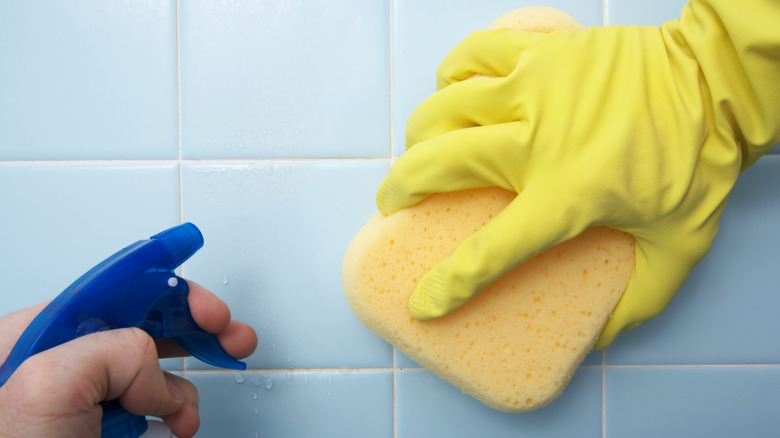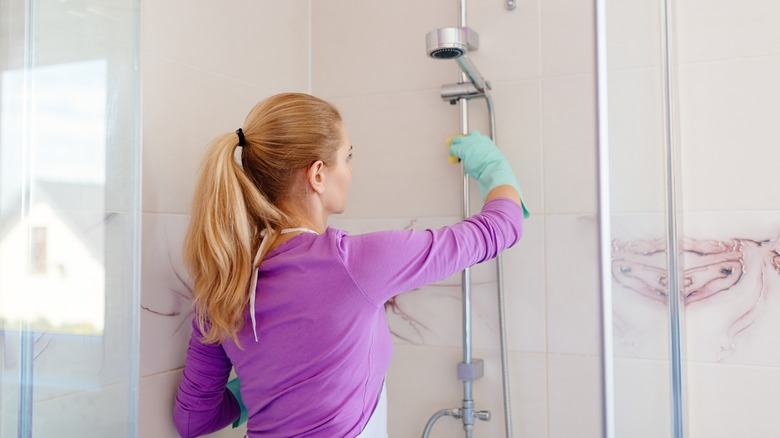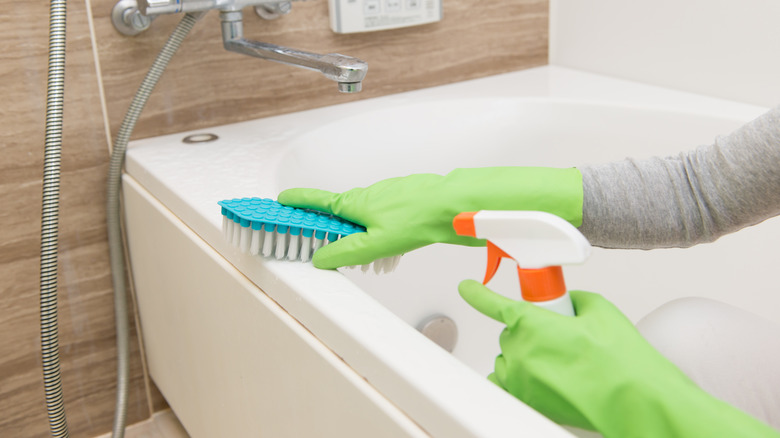Why You Should Keep A Bottle Of Hydrogen Peroxide In Your Shower
One of the many back-breaking chores that most of us avoid as much as possible is cleaning the bathroom, particularly the shower. Our showers accumulate dirt and grime due to constant exposure to soap scum, body oils, dead skin cells, and mineral deposits from water. These substances create a breeding ground for bacteria and mold, leading to unsightly stains, odors, and potential health hazards. Regularly cleaning your shower prevents buildup, prolonging the lifespan of shower surfaces and fixtures. Neglecting cleaning can result in stubborn stains, deterioration of grout, and potential structural damage, posing safety risks and necessitating costly repairs. By establishing a consistent cleaning routine, you can maintain your shower as an inviting space that promotes cleanliness instead. One simple way to stay ahead of the grime in your shower is to keep a bottle of hydrogen peroxide handy or even in your shower.
Hydrogen peroxide is a highly effective cleaning agent for showers due to its powerful oxidizing properties. It breaks down organic matter, kills bacteria and mold, and helps lift dirt and stains with its foaming action. By keeping a bottle of hydrogen peroxide in the shower — it becomes easily accessible for spot cleaning – and you can prevent buildup before it becomes a more significant issue. Moreover, hydrogen peroxide is non-toxic and environmentally friendly, making it a safe and sustainable choice for maintaining a clean and healthy shower. So, if you're looking for a quick fix for your soiled shower, look no further than hydrogen peroxide.
Using hydrogen peroxide in your shower
Cleaning a shower with hydrogen peroxide can effectively tackle dirt, grime, and stains while also sanitizing the surfaces. To begin, gather the necessary supplies, including hydrogen peroxide, a spray bottle, baking soda (optional for tougher stains), a scrub brush or sponge, and gloves for protection. Start by diluting the hydrogen peroxide with water in a spray bottle. A common ratio is one part hydrogen peroxide to two parts water, but you can adjust according to the severity of the stains and the type of surface being cleaned. Shake the bottle to ensure the solution is well-mixed before application.
Spray the diluted hydrogen peroxide onto the surfaces of the shower, focusing on areas with visible stains or grime buildup. Allow the solution to sit for several minutes to penetrate and loosen the dirt and stains. Sprinkle baking soda onto the dampened surfaces for tougher stains or areas with stubborn grime. Baking soda acts as a mild abrasive and can enhance the cleaning power of the hydrogen peroxide.
Using a scrub brush or sponge, gently scrub the surfaces to agitate the dirt and stains. Pay extra attention to grout lines, corners, and other hard-to-reach areas where mold and mildew accumulate. After scrubbing, rinse the shower thoroughly with water to remove the cleaning solution and loosened debris. Use a clean cloth or squeegee to wipe down the surfaces and remove excess moisture. Finally, inspect the shower to ensure all stains and grime have been effectively removed.
Precautions for using hydrogen peroxide in your shower
While hydrogen peroxide can be a powerful cleaning agent, when using it, you must never mix it with other cleaners. Combining hydrogen peroxide with substances like ammonia or vinegar can pose serious health risks. Even seemingly innocuous mixtures can lead to chemical reactions that produce toxic fumes, hot liquids, or even deadly explosions. Always use hydrogen peroxide on its own and avoid any temptation to blend it with other cleaning agents. This precaution is crucial for ensuring your safety and the effectiveness of the cleaning process. Stick to using hydrogen peroxide independently, following recommended dilution ratios, and always read product labels for potential compatibility issues with other cleaning products.
When using hydrogen peroxide to clean a shower, handle it properly to ensure safety. First, avoid contact with eyes and skin by wearing protective gloves and goggles. If contact occurs, flush the affected area with water and seek medical attention if irritation persists. Then, ensure adequate ventilation in the bathroom to minimize exposure to fumes. Open any nearby windows or use exhaust fans to dissipate the vapors. Wearing a mask can also prevent you from inhaling any dangerous fumes or aerosolized mold particles from the cleaning process. Finally, store hydrogen peroxide in a cool, dark place away from children and pets.


